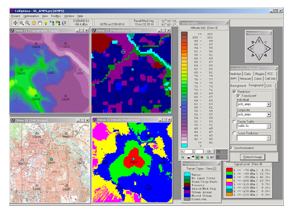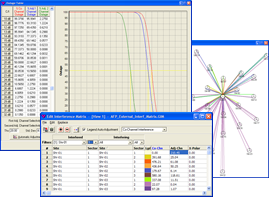CelOptima™
Comprehensive Analysis, Optimization and Automatic Frequency Planning (AFP) of Wireless Systems
 CelOptima™ aids wireless designers, engineers, and operators in the comprehensive analysis and optimization of wireless systems. With CelOptima™ users can performs the most intricate, detailed optimizations for the most complex wireless systems, including the convergence of traditional mobile, 3G & 4G (voice/data/image/multimedia), and broadband fixed wireless systems. CelOptima™ aids wireless designers, engineers, and operators in the comprehensive analysis and optimization of wireless systems. With CelOptima™ users can performs the most intricate, detailed optimizations for the most complex wireless systems, including the convergence of traditional mobile, 3G & 4G (voice/data/image/multimedia), and broadband fixed wireless systems.
CelOptima™ allows users to save significant amounts of time and avoid continuous system adjustments. As an optimization tool, CelOptima™ can double the traffic capacity of a wireless system and, at the same time, improve system performance. For rapid and reliable wireless optimization, CelOptima™ allows users to make better use of spectrum, increase quality of service, reduce capital investment, and reduce operational expenditures.
Hand-off thresholds and frequency planning for the most complex wireless systems can be automatically maximized. Applying the proprietary OPTIMA algorithm, CelOptima™ gives the best solution in the shortest time, so that users can perform an unlimited number of “what if” scenarios.
Harnessing the most sophisticated software to drive complex optimization procedures makes CelOptima™ a unique, powerful tool for assessing the toughest performance evaluation problems.
CelOptima™ first assembles a unique interrelation matrix among all radios - MATRIX. The software assesses the influence of all system servers at each point in the system, and then weights this influence with a traffic factor, derived from a special raster traffic layer created from demographics or switch data. The MATRIX data form the basis for calculation of ideal hand-off levels – where hand-off requests are minimized and the desired number of hand-offs is preserved.
 Using the OPTIMA algorithm, frequencies are assigned to the RF channels in such a way that overall interference is minimized. Geographic traffic distribution can be factored into the optimization solution so that any potential interference is restricted to areas with the least traffic. Using the OPTIMA algorithm, frequencies are assigned to the RF channels in such a way that overall interference is minimized. Geographic traffic distribution can be factored into the optimization solution so that any potential interference is restricted to areas with the least traffic.
In addition to working with existing plans, CelOptima™ software can be adjusted for any proposed modifications, including the increase or reduction of channels. With CelOptima™ , you can prioritize certain areas and/or restrict the use of certain frequencies at given sites. CelOptima™ also gives you the ability to optimize codes, polarities, and hopping sequence allocations.
The outstanding feature of the CelOptima™ engine is that it allows you to optimize sequentially. For example, once you have completed your frequency optimization, you can assign a first level of codes (e.g., SAT) based on the initial frequency assignments; then you can overlay this with a second level of code assignment (e.g., DCC or DVCC), and so on.
CelOptima™ is particularly well-suited to the optimization of mobile systems. Optimized offsets are determined by incorporating relative signal strengths at each point, the distance between competing sites, and the offset window in use. This unique CelOptima™ application delivers precise results and far exceeds the capabilities of other optimization tools.
The flexibility, versatility, and speed of CelOptima™ makes it the most valuable optimization tool available to wireless planners.
Neighborhood Analysis
- Automatic neighbor lists generation
- Handover thresholds calculation
- Handover thresholds calculation
Advanced Relationship Matrix
- Multiple inputs can be used independently or combined:
- Prediction data
- Switch data
- Drive test data
- Sector-To-Sector relationship is calculated
- Traffic weighted analysis
- Mobility / Priority geographic regions
- Power control and fading calculations
- Consideration of the effects of subscribers on multi-story buildings
|
Multi-Technology Support
- LTE & LTE Advanced
- WiMAX & WI-FI
- HSPA/HSPA+
- UMTS/WCDMA
- EDGE
- GSM
- GPRS
- LMDS/MMDS
- Digital TV /Video
- DVB-SH
- LMR/PMR
- IS2000
- CDMA
- TDMA
- AMPS
- Wireless Backhaul
|
Automatic Resources Planning
- Multiple technology support
- Resource blocking by system or by sector
- Variable reuse pattern
- Full frequency hoping support
- Multiple-layer resource planning (carriers, color codes, offset indexes)
- Automatic gain consideration for: Frequency diversity
- Interference diversity
- DTX
- Fractional loading (per sector analysis)
- Support for MRP (Multiple Reuse Pattern)
|
Performance Analysis
Presentation
Integrated GIS Platform
- Morphology height defined in a pixel basis
- Multiple image layers
- Regions and sub-regions with attributes
- Linear networks
- Multi-layered traffic information
|
Accurate Propagation Models
- Multi morphology considered for each path
- RF propagation parameters calibration per morphology, instead of per sector, increasing the re-usability of the propagation parameters throughout the design area
- Little or no drive test data required
- Highest propagation parameters reuse in the industry
|
Database Management
- Project Database is fully synchronized with the graphical views (HyperWindows™)
- Users can easily input individual parameters for each Service Class analyzed and for Radio Base Stations designed
- Global changes based on queried sub-sets of master project database
- RDBMS interface
|
|